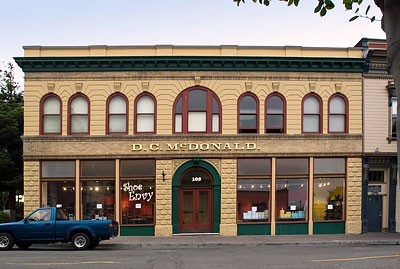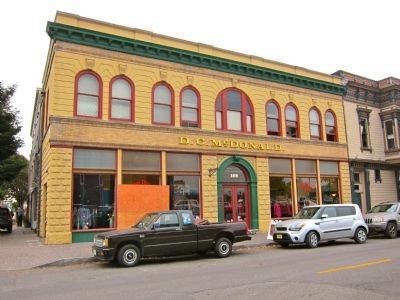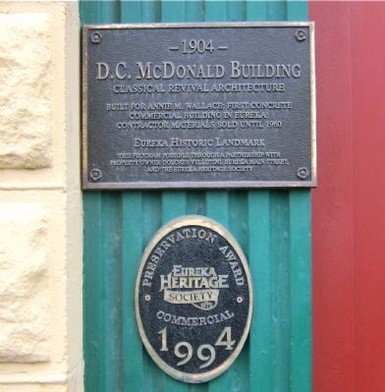D.C. McDonald Building
Introduction
Author-Uploaded Audio
00:00 / 00:00
Listen to a narration of this entry's description by Jenevieve Hughes.
Text-to-speech Audio
Images
McDonald Building today appears much as it did when it was first built in 1904 for the D.C. McDonald Building Supply Company

In 2017, the artist Amy Stewart created this artistic rendering of the McDonald Building using coffee grounds to create the varying shades and coloration

Historical marker mounted on pilaster, left side of entryway

Historical marker mounted on pilaster, left side of entryway

Backstory and Context
Author-Uploaded Audio
00:00 / 00:00
Listen to a narration of this entry's description by Jenevieve Hughes.
Text-to-speech Audio
In 1904, D.C. McDonald built this two-story masonry structure to house his successful building supply company in Eureka. This company provided the tools and building materials for many other local and regional businesses in the early twentieth century. The property itself is considered an excellent example of Classical Revival architecture, which was popular during this era.
The Classical Revival style is showcased in features such as the fluted pilasters, which support the arched entryway, as well as the decorative scrollwork on the second story molding. This building was constructed in brick and molded concrete, which was designed to imitate stone, particularly the "rusticated, rough-textured concrete blocks" that were molded into piers on the lower story. This was the first concrete building in Eureka. The second story features frosted arched transom windows, each showcasing a keystone above their respective arches. Between the first and second stories, a wide brick band prominently displays the name of the D.C. McDonald Company in gold lettering.
The property was owned and occupied by the D.C. McDonald Company from 1904 until the 1960s, at which time a motorcycle dealership took over the building. Despite several other commercial uses over the years, the brick and concrete facade of this building remains unaltered. As such, it continues to reflect the appearance of the property at the time when the D.C. McDonald company served the community of Eureka by selling building supplies. Today, this property continues to evoke the period of industrial growth and commercial activity in early twentieth-century Eureka.
The D.C. McDonald Building was listed on the National Register of Historic Places in 1982. Since 1991, it has also contributed to the National Register of Historic Places as a part of the Eureka Old Town Historic District. In 1994, a historical plaque was placed at the site, at which time the current owner of property received a Preservation Award from the Eureka Heritage Society. The plaque also lists the property as a Eureka Historic Landmark. The historical plaque is mounted on the pilaster to the immediate left of the entryway.
Cite This Entry
Hughes, Jenevieve . "D.C. McDonald Building." Clio: Your Guide to History. November 13, 2020. Accessed April 2, 2025. https://theclio.com/entry/96818
Sources
"McDonald Building", Noe Hill. Accessed March 19th 2020. https://noehill.com/humboldt/nat1982000966.asp.
"McDonald, D.C., Building - Eureka", Waymarking. Accessed March 19th 2020. https://www.waymarking.com/waymarks/WMK0MF_McDonald_DC_Building_Eureka_California.
"Nomination Form: Eureka Old Town", NPS. Accessed March 19th 2020. https://npgallery.nps.gov/pdfhost/docs/NRHP/Text/91001523.pdf.
Ruppenstein, Andrew. "D.C. McDonald Building", Hmdb. August 1st 2018. Accessed March 19th 2020. https://www.hmdb.org/m.asp?m=61221.
Noe Hill
Amy Stewart, artist; D.C. McDonald Building Official Facebook Page
Andrew Ruppenstein, Historical Marker Database
Andrew Ruppenstein, Historical Marker Database

